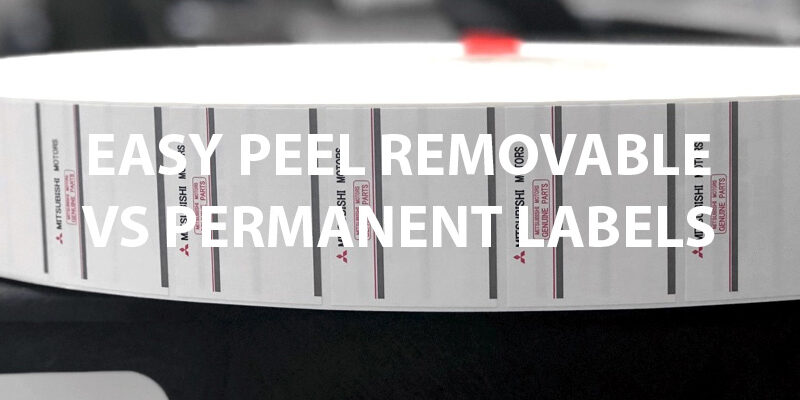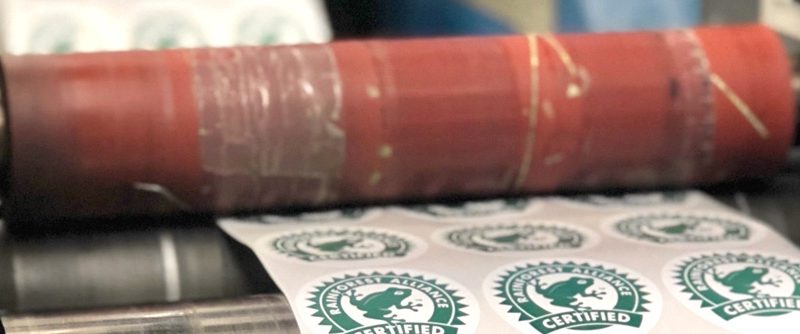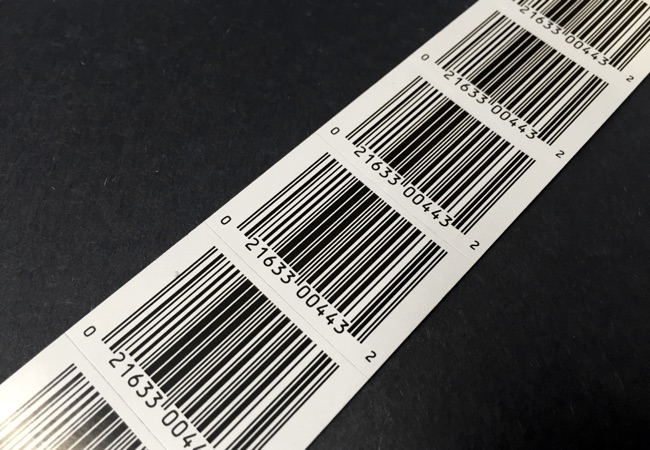Label adhesives might just be the last thing on your mind when designing your product packaging. But the wrong kind of adhesive can have a bad impact on your product design.
Nobody wants to buy an expensive frame or dish only to find the label won’t peel off. Almost worse is trying to remove an adhesive that leaves a sticky residue. Easy peel labels offer an excellent solution for labels that need to stay put…until it’s time for the customer to remove them. On the other hand, when you need a label to stay for a long period of time, there’s nothing more frustrating than a label that just falls off.
Choosing between removable labels and permanent labels doesn’t have to be a difficult decision. Which one is best for you? That will depend on your specific needs. Read on to learn about the differences between easy peel removable labels and permanent labels.
Removable Labels
What are removable labels? They’re labels that come off easily without leaving behind sticky adhesive or pieces of the label. They use a non-permanent adhesive that doesn’t form a strong bond with the surface. When designing your labels, you’ll want to take into account the timeframe between applying the label and the customer removing it. Different kinds of removable adhesives will be used based on this timeframe. That’s because over time, most adhesives actually get stronger. For example, produce labels only need to stay on for a few days to a few weeks. Non-perishable goods, on the other hand, will likely spend a lot more time with the label on. The removable adhesive used will differ based on the time the label will spend on the product.
Another thing that has to be considered when designing your removable labels is the surface material of your product or packaging. Picking the right adhesive is mostly a matter of chemistry. The material the label needs to adhere to will affect how the adhesive behaves. That’s why at Coast Label, we set you up with our in-house application specialists to help you engineer the perfect label.
The facestock of your label (the material your label is printed on) also impacts the removability of your label. If your facestock is weak, but your adhesive is strong, remnants of paper will be left on the product. The right facestock needs to be paired with the right adhesive in order to engineer a truly easy-to-peel removable label.
Pros and Cons of Removable Labels
As with any product, removable labels have their pros and cons. Clearly, one of the biggest benefits of removable labels is how easily they are removed. You don’t have to scratch or pick at the label to remove it from the surface it’s applied to. And you don’t have to worry about sticky residue being left behind. Plus, removable labels won’t cause surface damage, such as removing some of the paint or tearing pieces of the cardboard packaging.
As easy as they are to use, removable labels do have some drawbacks. First of all, the removable adhesive is more expensive than a permanent adhesive, which means removable labels come with a higher cost. Removable labels are also not intended for use in cold temperatures. The adhesive performs best between 55 degrees and room temperature. Additionally, removable labels aren’t intended for rough surfaces.
Pros:
- Easy to remove label
- Doesn’t leave behind adhesive
- Doesn’t damage surface
Cons:
- More costly
- Doesn’t function well in cold temperatures
- Doesn’t work as well on rough surfaces
Uses of Removable Labels
Do you need removable labels? Here are a few common uses for removable labels:
- Price tags and product labels
- Produce, such as cucumbers, apples, watermelon, peppers, etc.
- Medical information and records
- Car maintenance decals
- Asset tracking
- File folders and office records
- Use now coupons on retail items
- Specimen labels
- Temporary equipment
- Reusable containers
- Retail products
Repositionable Labels
Sometimes, you don’t need your label to be removable forever, just for a short time. For example, if you mess up the application of your label and want to adjust it. The kind of label you’ll be looking for here is a repositionable label. Because the adhesive strengthens over time, repositionable labels will remain fixed to the product or piece of equipment after it’s had time to set. Until then, you’ll be able to adjust the placement of the label to get it just right.
Repositionable labels use an acrylic label adhesive. The acrylic takes time to bond with the surface, which is what allows the label to be repositioned. Repositionable labels are great for any kind of product you label by hand. You might also want repositionable labels when accurate placement is of the utmost importance.
Permanent Labels
As the name implies, permanent labels use an adhesive that forms a permanent bond with the surface it’s being applied to. If you need to make sure your labels don’t peel off, you want permanent adhesive labels. The degree of permanence will depend on a number of factors, including the surface the labels will be applied to, the facestock, and the environment. An application specialist at Coast Label will ask you several questions about the intended use of your labels to help you pick the right permanent adhesive.
Pros and Cons of Permanent Labels
Permanent labels have a lot of benefits to them. For starters, the adhesive is less expensive, so permanent labels cost less than removable labels. Permanent labels form a secure bond with the surface they’re being applied to, so you can be sure they won’t peel off. In fact, the right kind of adhesive will ensure that your labels last the lifetime of the product.
There are some drawbacks to using permanent labels. If you need to remove the label, one of two things will happen. One, the label will leave behind some adhesive. Or two, the surface might be damaged. Permanent labels are great for their intended purpose: staying put when you need a secure, one-time-use label.
Pros:
- Cost less than removable labels
- Forms a secure bond with surface
- Lasts the entire life of the product
- Secure, one-time-use
Cons:
- Leaves a residue behind when removed
- May damage surface when removed
Uses of Permanent Labels
Permanent labels are probably the most common kind of label used, partly because the adhesive is less expensive. Permanent labels are great for whenever you need your label to stay put. Here are some of the most common uses of permanent labels:
- Shipping and handling
- Envelopes
- Packaging
- Bottles and containers
- Barcodes
- Identification
- Safety labels
- Equipment and tags
- Tamper-proof labels for added security
- Outdoor products and labels
- Warning labels
- Chemical labels
- Automotive labels
Easy Peel Removable Labels vs Permanent Labels Conclusion
Which kind of label is best for you? That’s going to depend on your unique situation. If you’re looking for labels that are easy to peel off without leaving behind a residue, removable labels will be your best choice. This might be in a healthcare setting or with luxury goods. On the other hand, when you need labels that won’t come off, permanent labels are probably what you’re looking for. Permanent labels stay put on anything from manufacturing equipment to shipping packages.
At Coast Label, we can help you engineer the perfect label for your business. Whether you’re looking for removable labels or permanent labels, we’ve got you covered. Contact us today for a free proposal.



